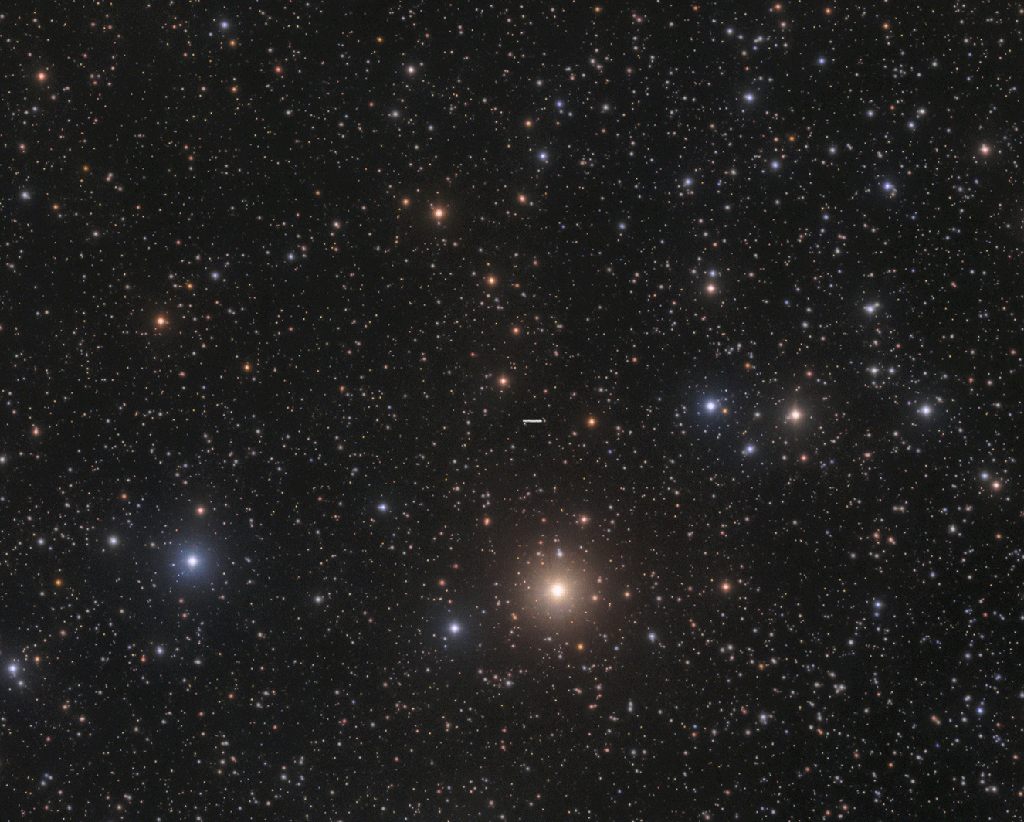31. December 2021
JWST 太空望遠鏡 當咧去 L2 點 ê 路-lih

探索宇宙1!逐工會揀一幅無仝款 ê 影像抑是相片,𤆬你熟似咱這个迷人 ê 宇宙,閣有專業天文學者2為你3解說4。
- 原始文章:JWST on the Road to L2
- 影像來源 kah 版權:Malcolm Park (North York Astronomical Association)
- 台文翻譯:An-Li Tsai (NCU)
[漢羅] JWST 太空望遠鏡 當咧去 L2 點 ê 路-lih
這張縮時攝影圖內底,有 JWST 太空望遠鏡 tī 天星滿滿 ê 夜空咧行,這馬拄 ùi 獵戶座頭前行過。 伊飛過月球了後,繼續 tùi 伊 ê 終點飛去。 這張是 tī 12 月 28 號翕 ê。 這个縮時攝影是每 10 分鐘翕一張,攏總翕 12 張。 Kā in 對予齊齊了後,閣疊一張有足濟背景星 ê 深空彩色相片,才產生這張動畫。 JWST 太空望遠鏡 12 月 25 發射了後過 2 工半,to̍h 已經飛超過月球軌道 ê 懸度矣。 紲落來伊會 ùi 地球 ê 重力脊 飛到踅 L2 點 ê 暈輪軌道。 L2 點 是 地球-太陽 系統 ê Lagrange 點 ê 其中一點。 Lagrange 點 tī 太空中是一个足方便 ê 所在。 假設太空中有一粒大天體(比論講地球)踅另外一粒大天體(比論講太陽)leh 行,Lagrange 點 to̍h 是這个系統內底 引力 kah 向心力平衡 ê 所在。 Tī 遮 ê 物件會 kah 這兩粒大天體做伙行。 所以,若是有一个質量較細 ê 物件,比論講太空船,to̍h 較愛留踮這位。 L2 點是 5 个 Lagrange 點 ê 其中一點。 伊 tī 地球-太陽 ê 連線頂懸,差不多離地球 150 萬公里遠 ê 所在。 JWST 太空望遠鏡會 tī 明年 1 月 23 飛到 L2 點,這 ê 時陣已經是發射了後 ê 第 29 工矣。 伊這馬已經離開地球表面重力範圍。 你嘛會當 tī 線頂追蹤伊 ê 進度,看伊複雜 ê 安搭過程。
[POJ] JWST Thài-khong-bōng-oán-kiàⁿ tng-leh khì L-two tiám ê lō͘-lih
Chit-tiuⁿ sok-sî-liap-iáⁿ-tô͘ lāi-té, ū JWST thài-khong-bōng-oán-kiàⁿ tī thiⁿ-chhiⁿ móa-móa ê iā-khong leh kiâⁿ, chit-má tú ùi La̍h-hō͘-chō thâu-chêng kiâⁿ-kòe. I poe-kòe Goe̍h-kiû liáu-āu, kè-sio̍k tùi i ê chiong-tiám poe khì. Chit-tiuⁿ sī tī cha̍p-jī goe̍h jī-poeh hip ê. Chit-ê sok-sî-liap-iáⁿ sī múi cha̍p hun-cheng hip--chi̍t-tiuⁿ, lóng-chóng hip cha̍p-jī tiuⁿ. Kā in tùi hō͘ chiâu-chê liáu-āu, koh tha̍h chi̍t-tiuⁿ ū chiok-chōe pōe-kéng-chhiⁿ ê chhim-khong chhái-sek siòng-phìⁿ, chiah sán-seng chit-tiuⁿ tōng-ōe. JWST thài-khong-bōng-oán-kiàⁿ cha̍p-jī goe̍h jī-gō͘ hoat-siā liáu-āu kòe nn̄g-kang-pòaⁿ, to̍h í-keng poe chhiau-kòe Goe̍h-kiû kúi-tō ê koân-tō͘ ah. Sòa-lo̍h-lâi i ē ùi Tē-kiû ê tiōng-le̍k-chit poe-kàu se̍h L-two tiám ê n̄g-lûn kúi-tō. L2 tiám sī Tē-kiû-Thài-iông hē-thóng ê Lagrange tiám ê kî-tiong chi̍t-tiám. Lagrange tiám tī thài-khong tiong sī chi̍t-ê chiok hong-piān ê só͘-chāi. Ká-siat thài-khong tiong ū chi̍t-lia̍p tōa thian-thé (pí-lūn-kóng Tē-kiû) se̍h lēng-gōa chi̍t-lia̍p tōa thian-thé (pí-lūn-kóng Thài-iông) leh kiâⁿ, Lagrange tiám to̍h sī chit-ê hē-thóng lāi-té ín-le̍k kah hiòng-sim-le̍k pêng-hêng ê só͘-chāi. Tī chia ê mi̍h-kiāⁿ ē kah chit nn̄g-lia̍p tōa thian-thé chò-hóe kiâⁿ. Só͘-í, nā-sī ū chi̍t-ê chit-liōng khah-sè ê mi̍h-kiāⁿ, pí-lūn-kóng thài-khong-chûn, to̍h khah-ài lâu tiàm chit-ūi. L-two tiám sī gō͘ ê Lagrange tiám ê kî-tiong chi̍t-tiám. I tī Tē-kiû-Thài-iông ê liân-sòaⁿ téng-koân, chha-put-to lî Tē-kiû chi̍t-pah-gō͘-cha̍p-bān kong-lí hn̄g ê só͘-chāi. JWST thài-khong-bōng-oán-kiàⁿ ē tī môa-nî it goe̍h jī-saⁿ poe-kàu L-two tiám, chit-ê sî-chūn í-keng sī hoat-siā liáu-āu tē jī-cha̍p-káu kang ah. I chit-má í-keng lī-khui Tē-kiû piáu-bīn tiōng-le̍k hoān-ûi. Lí mā ē-tàng tī soaⁿ-téng tui-chong i ê chìn-tō͘, khòaⁿ i ho̍k-cha̍p ê an-tah kòe-têng.
[KIP] JWST Thài-khong-bōng-uán-kiànn tng-leh khì L-two tiám ê lōo-lih
Tsit-tiunn sok-sî-liap-iánn-tôo lāi-té, ū JWST thài-khong-bōng-uán-kiànn tī thinn-tshinn muá-muá ê iā-khong leh kiânn, tsit-má tú uì La̍h-hōo-tsō thâu-tsîng kiânn-kuè. I pue-kuè Gue̍h-kiû liáu-āu, kè-sio̍k tuì i ê tsiong-tiám pue khì. Tsit-tiunn sī tī tsa̍p-jī gue̍h jī-pueh hip ê. Tsit-ê sok-sî-liap-iánn sī muí tsa̍p hun-tsing hip--tsi̍t-tiunn, lóng-tsóng hip tsa̍p-jī tiunn. Kā in tuì hōo tsiâu-tsê liáu-āu, koh tha̍h tsi̍t-tiunn ū tsiok-tsuē puē-kíng-tshinn ê tshim-khong tshái-sik siòng-phìnn, tsiah sán-sing tsit-tiunn tōng-uē. JWST thài-khong-bōng-uán-kiànn tsa̍p-jī gue̍h jī-gōo huat-siā liáu-āu kuè nn̄g-kang-puànn, to̍h í-king pue tshiau-kuè Gue̍h-kiû kuí-tō ê kuân-tōo ah. Suà-lo̍h-lâi i ē uì Tē-kiû ê tiōng-li̍k-tsit pue-kàu se̍h L-two tiám ê n̄g-lûn kuí-tō. L2 tiám sī Tē-kiû-Thài-iông hē-thóng ê Lagrange tiám ê kî-tiong tsi̍t-tiám. Lagrange tiám tī thài-khong tiong sī tsi̍t-ê tsiok hong-piān ê sóo-tsāi. Ká-siat thài-khong tiong ū tsi̍t-lia̍p tuā thian-thé (pí-lūn-kóng Tē-kiû) se̍h līng-guā tsi̍t-lia̍p tuā thian-thé (pí-lūn-kóng Thài-iông) leh kiânn, Lagrange tiám to̍h sī tsit-ê hē-thóng lāi-té ín-li̍k kah hiòng-sim-li̍k pîng-hîng ê sóo-tsāi. Tī tsia ê mi̍h-kiānn ē kah tsit nn̄g-lia̍p tuā thian-thé tsò-hué kiânn. Sóo-í, nā-sī ū tsi̍t-ê tsit-liōng khah-sè ê mi̍h-kiānn, pí-lūn-kóng thài-khong-tsûn, to̍h khah-ài lâu tiàm tsit-uī. L-two tiám sī gōo ê Lagrange tiám ê kî-tiong tsi̍t-tiám. I tī Tē-kiû-Thài-iông ê liân-suànn tíng-kuân, tsha-put-to lî Tē-kiû tsi̍t-pah-gōo-tsa̍p-bān kong-lí hn̄g ê sóo-tsāi. JWST thài-khong-bōng-uán-kiànn ē tī muâ-nî it gue̍h jī-sann pue-kàu L-two tiám, tsit-ê sî-tsūn í-king sī huat-siā liáu-āu tē jī-tsa̍p-káu kang ah. I tsit-má í-king lī-khui Tē-kiû piáu-bīn tiōng-li̍k huān-uî. Lí mā ē-tàng tī suann-tíng tui-tsong i ê tsìn-tōo, khuànn i ho̍k-tsa̍p ê an-tah kuè-tîng.
[English] JWST on the Road to L2
This timelapse gif tracks the James Webb Space Telescope as it streaks across the stars of Orion on its journey to a destination beyond the Moon. Recorded on December 28, 12 consecutive exposures each 10 minutes long were aligned and combined with a deep color image of the background stars to create the animation. About 2.5 days after its December 25 launch, JWST cruised past the altitude of the Moon's orbit as it climbed the gravity ridge from Earth to reach a halo orbit around L2, an Earth-Sun Lagrange point. Lagrange points are convenient locations in space where the gravitational attraction of one massive body (Earth) orbiting another massive body (Sun) is in balance with the centripetal force needed to move along with them. So much smaller masses, like spacecraft, will tend to stay there. One of 5 Lagrange points, L2 is about 1.5 million kilometers from Earth directly along the Earth-Sun line. JWST will arrive at L2 on January 23, 29 days after launch. While relaxing in Earth's surface gravity you can follow its progress and complicated deployment online.
詞彙學習
| 漢羅 | POJ | KIP | 華語 | English |
|---|---|---|---|---|
| JWST 太空望遠鏡 | JWST thài-khong-bōng-oán-kiàⁿ | JWST thài-khong-bōng-uán-kiànn | JWST 太空望遠鏡 | James Webb Space Telescope |
| 向心力 | hiòng-sim-le̍k | hiòng-sim-li̍k | 向心力 | centripetal force |
| 縮時攝影 | sok-sî-liap-iáⁿ | sok-sî-liap-iánn | 縮時攝影 | timelapse |
| L2 點 | L-two tiám | L-two tiám | L2 點 | Lagrange point L2 |
| 重力脊 | tiōng-le̍k-chit | tiōng-li̍k-tsit | 重力脊 | the gravity ridge |
| 暈輪軌道 | n̄g-lûn kúi-tō | n̄g-lûn kuí-tō | 暈輪軌道 | halo orbit |
| 獵戶座 | La̍h-hō͘-chō | La̍h-hōo-tsō | 獵戶座 | Orion |